Easements in Texas: Understanding everything before buying land

Introduction
Texas easements: if you're considering buying a lot in Texas, you need to identify, understand and quantify the impact of rights-of-way and other easements before you sign. These encumbrances can limit your uses (fencing, building, digging), authorize access to third parties (electricity, water, telecoms) or reserve a strip of your parcel for drainage. If not properly anticipated, Texas servitudes create additional costs, delay development and reduce resale value. Properly framed, they secure your work, avoid disputes and facilitate urban development.
Our aim: to give you an operational method for reading a title commitment, mapping easements to the survey (ALTA/NSPS if necessary), analyzing the impact on constructability, and negotiating the right adjustments (option period, exit clauses, site reconfiguration, even relocation). Below you'll find a checklist, a comparative table, a case study and a mini-FAQ for vocal SEO, all backed up by official and industry sources.
This article was written by the LandQuire team, specialists in land investment in the United States. Our experts analyze real estate strategies to assist French-speaking investors in their U.S. land acquisition projects.
🔗 Follow LandQuire on LinkedIn
✉️ Audit "easements & constructability " : Specialized land contact Texas
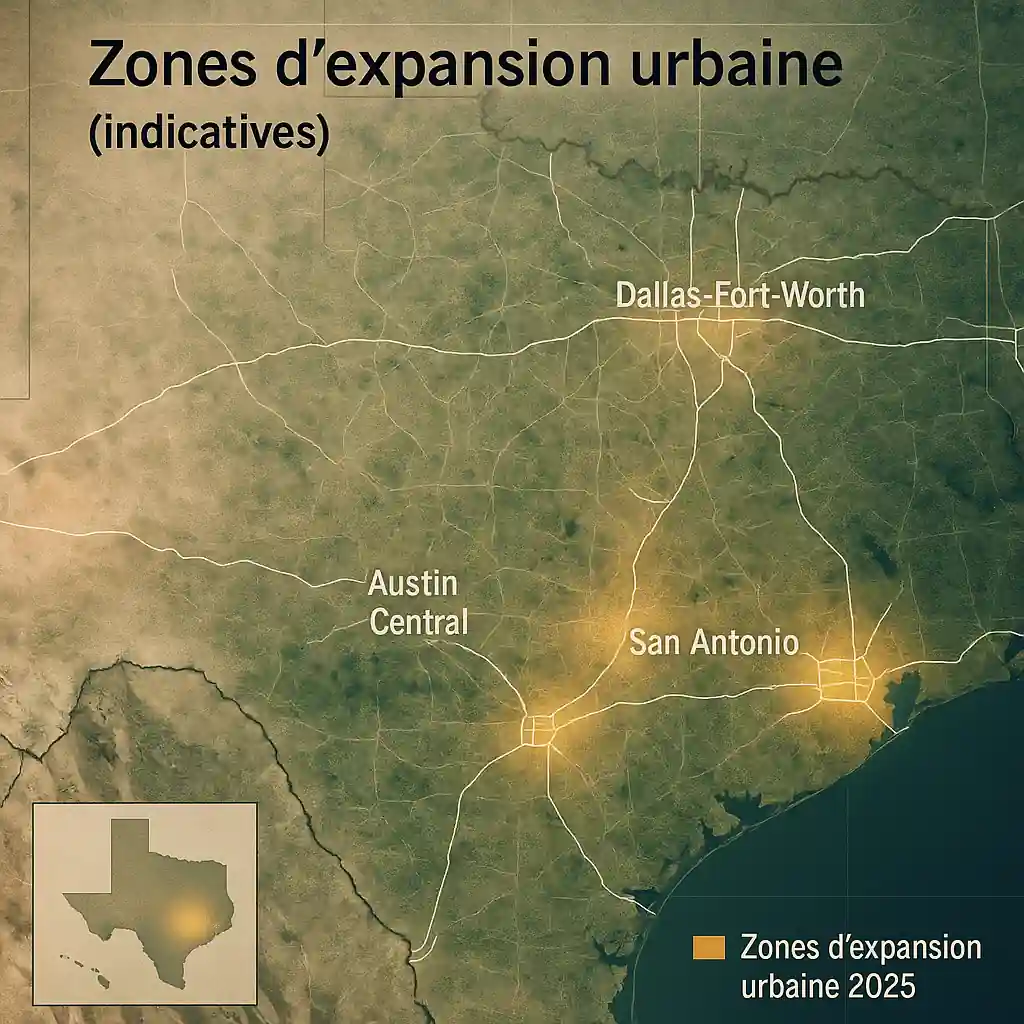
Why easements matter so much in Texas
Direct consequence: without early diagnosis, these easements in Texas for a plot of land reduce the surface area and displace your sites. They also affect truck access, drainage, sanitation and network installation. For example, a utility easement can block a driveway or impose a specific gate. In practice, plan ahead with a clear title commitment and an up-to-date survey, and map each strip. Then prioritize site reconfigurations and, if necessary, negotiate a relocation or handover in order to preserve value, timing and budget.
In the majority of LandQuire's 2024-2025 field audits, Texas terrain easements have a direct impact on development strategy (LandQuire internal, non-public data).
To remember
- Map each easement: title commitment (Schedule B) + updated survey (ALTA/NSPS if required).
- Anticipate ROW & utilities: check TxDOT/county projects and potential relocations (costs/deadlines).
- Negotiate early: sufficient option period, exit clauses, reconfigured layout = preserved value.
The practical impact of easements
In practice, easements on land in Texas are managed through title commitment, up-to-date surveys and appropriate contractual clauses. Hence the importance of structured due diligence: reading Schedule B, precise mapping and early negotiation to secure schedule, budget and constructability.
- Restrict the layout of a house, garage or outbuilding.
- Reduce buildable area by imposing setbacks and undeveloped strips.
- Design firefighter access routes, aisles and turning radii.
- Reserve a utility strip for electricity, water, gas and telecommunications.
- Allow maintenance and repair crews to enter periodically.
- Limit fences and gates or impose specific designs.
- Protect an embankment and channel rainwater via easement drainage.
- Show public right-of-way for future road widening (ROW).
- Constrain the location of the well, septic tank and landfill.
- Require minimum clearance for trucks, equipment and emergency services.
- Generate costs for relocating or rerouting existing networks.
- Affecting the resale value and marketing of subdivided lots.
Key definition
An easement is a limited right of use on another's property for a specific purpose (access, utility, drainage...). In Texas, an easement may be written or sometimes implied by statute or usage, and it "follows" the land (is attached to the property).
🔗 Source: Texas State Law Library - Easements
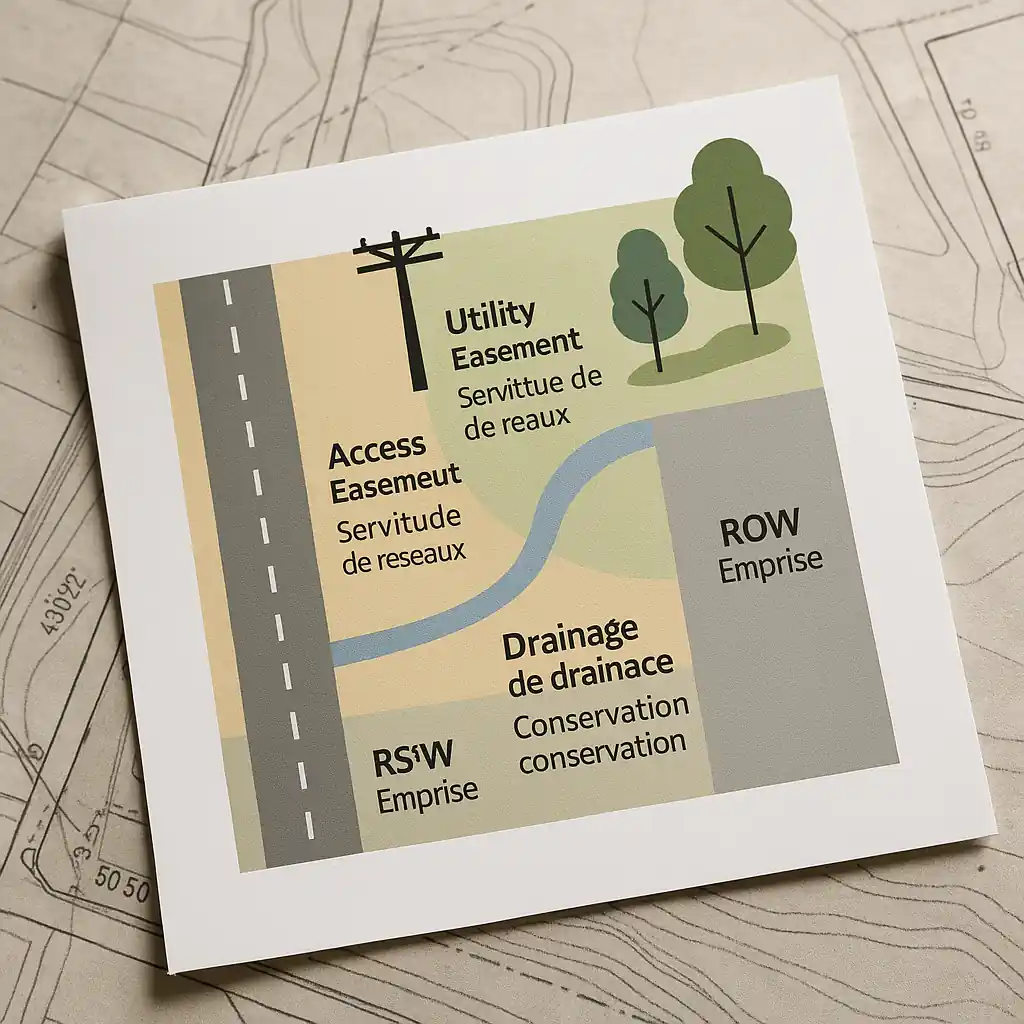
The 5 main easement families
1) Access easement(Ingress/Egress)
This access servitude (ingress/egress) requires precise drafting. First, check its nature: appurtenant (attached to the land) or in gross (for the benefit of a person). Specify whether access is exclusive or shared. Indicate authorized uses: passage, U-turn, short parking.
Take care of theroadbed: route described in metes & bounds, points of curvature, slope, ditch crossings. Plan structures: reprofiling, wearing course, culverts, water drainage. Establish a constant usable width, including in bends.
Managemaintenance: who pays, who works, how often. Anticipateemergency access: size, turning area, compatible gates. Interdict storage and planting that obstruct passage.
Describe signage and gates (width, locking, emergency access). Avoid "floating" easements: a plan must be appended to the title. If a future deviation is possible, frame it (procedure, costs, deadlines). Finally, register the deed with the county and have the access represented on the survey. This secures use and value in the context of Texas servitudes.
2) Utility easement (Electricity, Water, Telecoms)
Authorizes installation, access and maintenance of networks. Owner retains land but cannot interfere with reserved use.
Practical implications: 10-30 ft strip often unbuildable; periodic access for maintenance; agreement required for work/fencing; coordination required for relocation.
🔗 Practical ref: TxDOT - Right of Way & Utilities
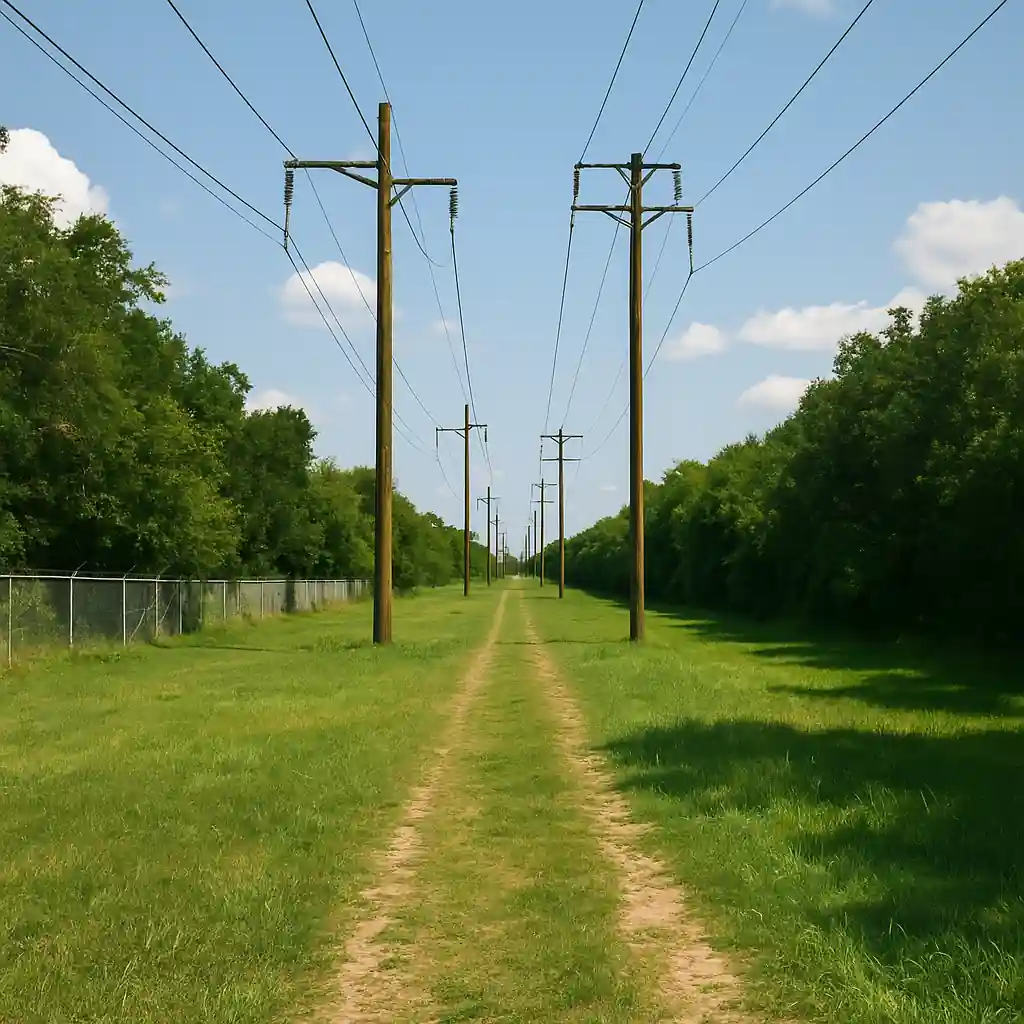
3) Easement drainage
This easement drainage protects stormwater runoff. It imposes a no-build / no-obstruction zone. No embankments, low walls, solid fences or plantations to impede the flow. Any modification requires a hydraulic study and the written agreement of the beneficiary.
Key points to be specified in the deed and survey:
- Detailed plate: ditch section, slopes, radii, berm heights.
- Structures: nozzles/bundles, energy dissipators, outlets, maintenance access.
- Maintenance: who mows, who clears, frequency, vehicle access (gate width).
- Setbacks: building recesses, slabs, pools, fences, deep-rooted trees.
- Liability: obstructed flow, downstream damage, emergency response procedure.
- Compatibility: utility network, individual sanitation (septic/landfill distances).
Good idea: check FEMA/FIRM maps and county drainage criteria, then accurately map easement with a survey. In the event of new sealing, plan for retention/detention and anti-erosion stabilization. Document these constraints in the Texas land easement due diligence to secure constructability, timing and costs.
4) Right-of-way (ROW)
Existing or planned public rights-of-way (roads, widenings). TxDOT coordinates utility acquisition and relocations.
In practice, TxDOT coordinates utility rights-of-way and relocations; access to private property requires a valid right (easement or deed). Systematically check widening projects with the county and Right-of-Way pages.
🔗 Ref. : TxDOT - Right of Way Division
5) Conservation / environmental easements
Restrict certain uses to preserve habitats, views or natural areas. They may offer tax benefits in specific cases, but strongly lock in developments.
🔗 Panorama : Texas Real Estate Research Center - Easements in Texas
Good to know
An easement is a real interest: find it in the title commitment (Schedule B) and map it on the survey. Without graphic representation, you underestimate its impact.
🔗 Teaching guide : Texas A&M AgriLife - Easements 101
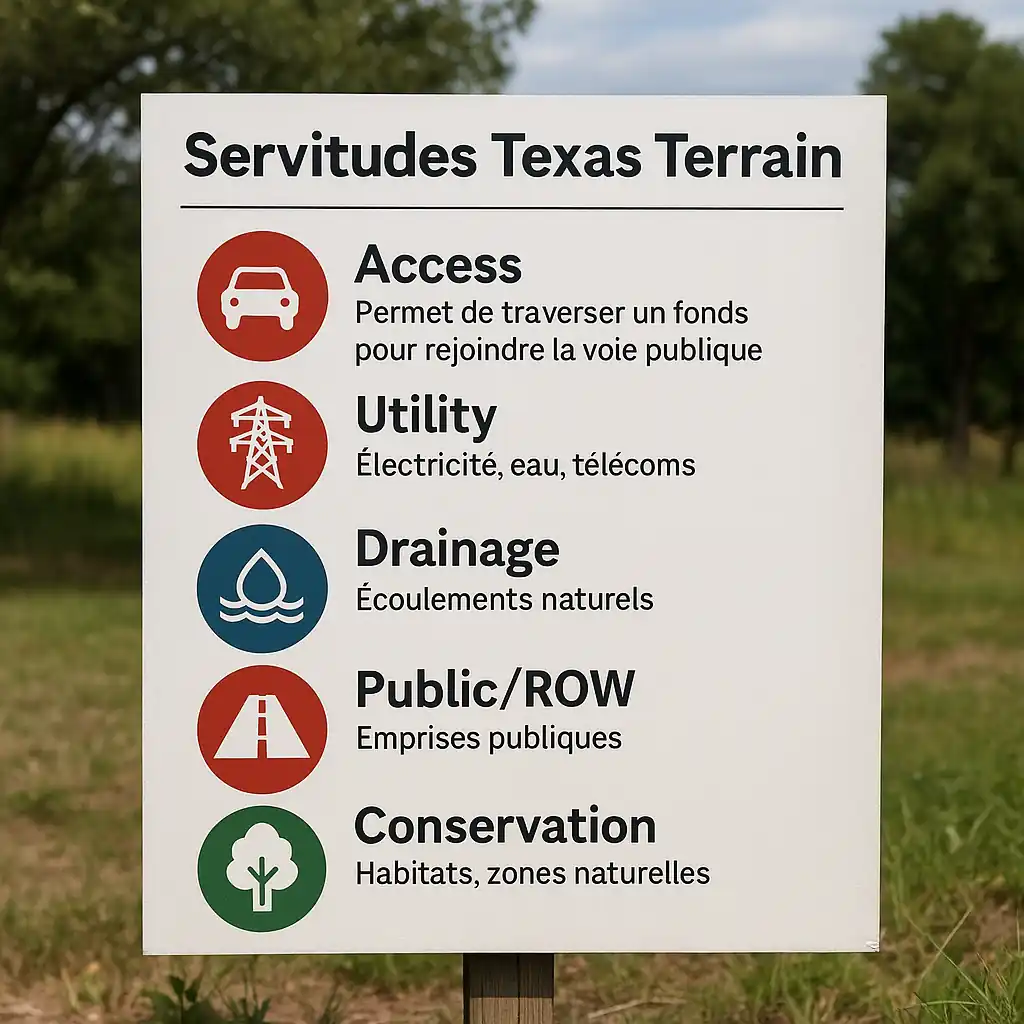
Before you buy: 10 essential checks
Texas land easements are managed during due diligence, not after. Our experience of 2024-2025 field audits confirms this golden rule (LandQuire internal feedback).
Checklist 2025
1) Title Search & Title Commitment (Schedule A/B)
Locate easements, restrictions, encroachments; identify uninsured exceptions; retrieve all referenced documents.
2) Recent survey (with representation of easements)
Require clear plan of affected strips; validate distances to future constructions; ALTA/NSPS if necessary.
3) T-47 Affidavit (if applicable)
Check historical consistency of improvements; verify absence of undeclared encroachments.
4) PLAT & county records
Consult subdivision plats; utility maps; identify planned enlargements.
5) Physical evidence on site
Posts, manholes, boxes; interrupted fences; visible talwegs & natural run-off.
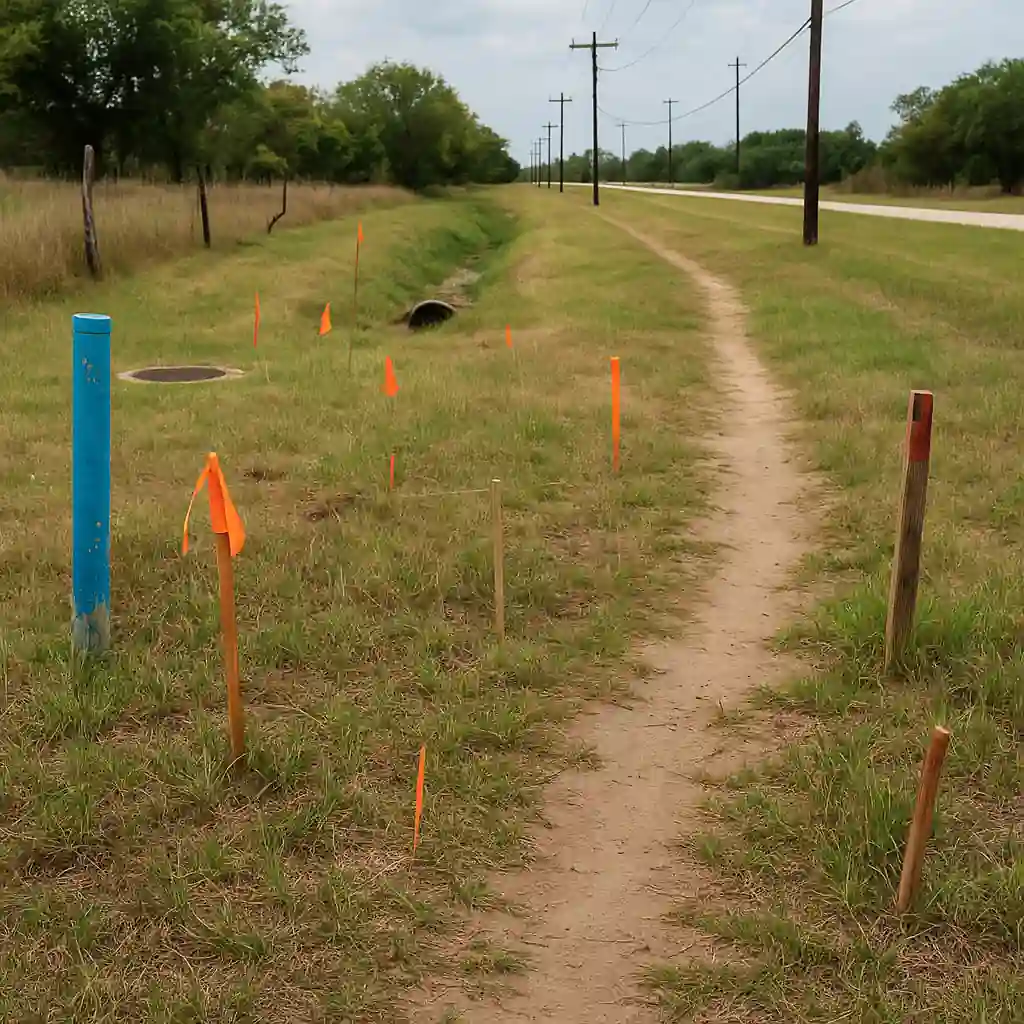
6) Existing access routes
Measure useful width (e.g. 30 ft); bearing capacity; slope; structures (culverts).
7) Sanitation compatibility
Check septic setbacks; distances to easements; connection constraints.
8) Shared easements
What about maintenance? cost-sharing with neighbors/HOA? existing agreements?
9) Feasibility of relocating utilities
Assess technical feasibility; costings & timescales; who bears the costs.
10) Protective contractual clauses
Negotiate a sufficient option period; conditions precedent; right of termination in the event of blocking discovery.
LandQuire feedback
In our 2024-2025 audits, a significant number of transactions required renegotiation following the discovery of poorly documented easements (LandQuire internal data). Rigorous due diligence remains your best protection.
🎯 Contact us: Targeting a rural lot in the San Antonio-Austin corridor? Ask for our due diligence checklist and a structured debriefing.
How to map your easements accurately
Three documents form the reference triptych.
1) The Title Commitment: your roadmap
Schedule B lists exceptions (easements, restrictions, rights-of-way). Each reference refers to a registered document to be retrieved.
Objective: read and summarize the scope (who? what? where? access? maintenance?).
2) The Survey (ALTA/NSPS or equivalent)
The updated survey includes all known and visible easements.
Technical requirements: exact dimensions (width, radii), precise alignments, validation of setbacks, compatibility with your projects.
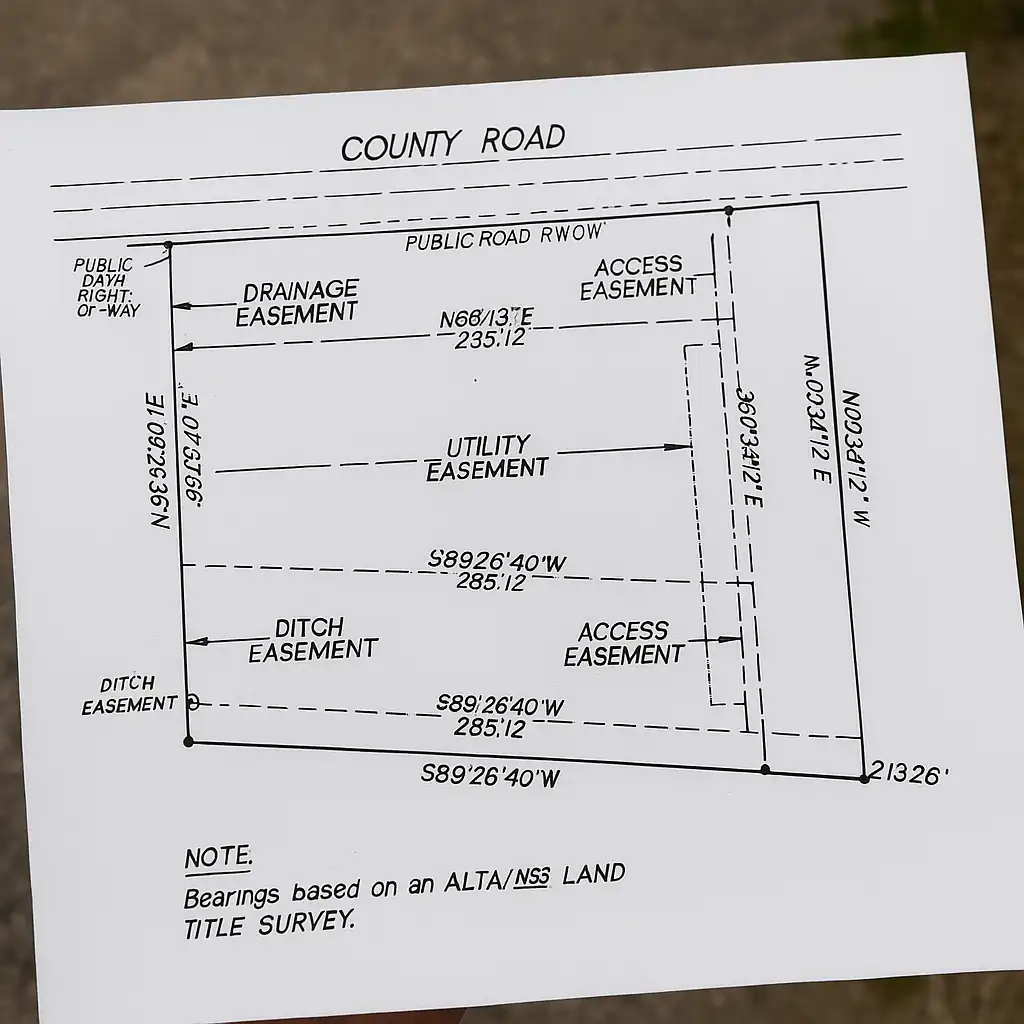
3) Public rights-of-way and widening projects
Good reflex: systematically ask the TxDOT Right-of-Way Division and the county about road extension plans. Utility relocations are negotiated on a case-by-case basis; the authority can coordinate but does not enter without a formalized right (easement/deed).
🔗 Entry point: TxDOT - Right of Way & Utilities
Financial impact and negotiation
Texas servitudes affect constructability, marketability and exit price. Three levers for optimization:
Quantifying impact
Useful surface area: calculate the buildable surface area after subtracting encumbered strips.
Example: a 30 ft by 300 ft easement represents approximately 0.21 "lost" acres.
Reconfiguring the layout
Reposition the house, driveway or pit to neutralize the constraint at minimum extra cost.
Negotiate early and precisely
Three options according to context:
- Purchase price discount;
- Partial relocation if technically possible;
- Negotiated modification / extinction.
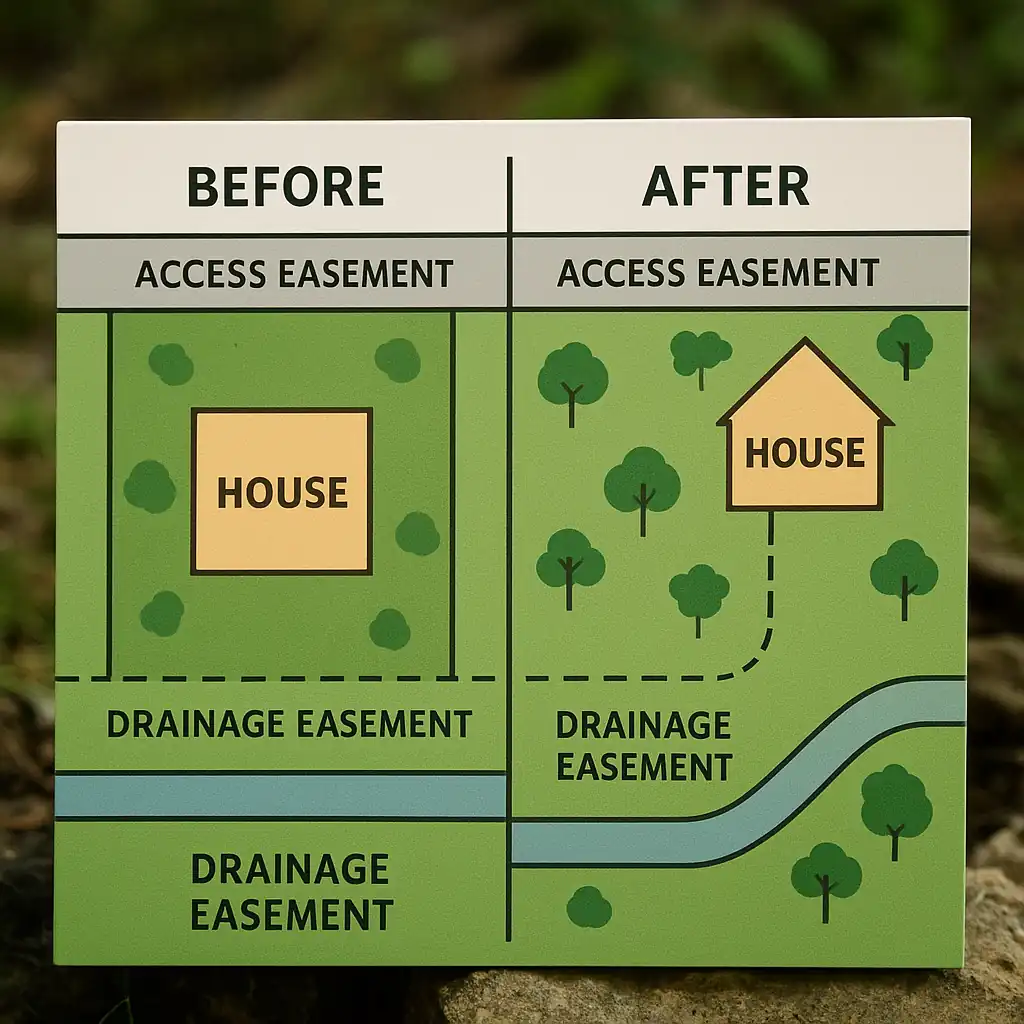
Comparative table (impact & action)
| Type of easement | Main impact | Priority action before purchase |
|---|---|---|
| Access(ingress/egress) | Decisive width/span | Get exact conditions (width, maintenance, schedules) |
| Utility (elec/water/telecom) | Non-buildable strip + maintenance access | Locate on survey, validate setbacks and gear passage |
| Drainage | Building ban | Check hydraulic profile and stability of talwegs |
| Public ROW | Risk of future enlargement | Check TxDOT/county plans, alignment distances |
| Conservation | Limited long-term use | Measuring restrictions and effect on resale value |
Utility relocation: key points and costs
Some utilities may be relocated if legally and technically possible, with coordination between licensees and ROW authorities.
Typical cost ranges observed:
- Electrical relocation: $15,000-50,000 (depending on distance)
- Water/sewer relocation: $20,000-80,000 (depending on depth)
- Telecom: $5,000-25,000 (depending on complexity)
🔗 Framework & processes : TxDOT - Utilities
Drafting and reading a servitude: the 6 essential clauses
- Purpose & beneficiary: precise purpose, identified beneficiary.
- Plate: metric description(metes & bounds), plan attached (survey).
- Access & maintenance: who enters, when, with what equipment; who maintains and under what conditions.
- Restrictions on use: constructions/planting authorized or not; gates and conditions of use.
- Transfer & duration: appurtenant (attached to the fund) or in gross, duration, assignability.
- Compensation: liability in the event of damage (fence, access road, crops).
Pro Tip LandQuire
To avoid legal blind spots, have documents proofread by a local real estate attorney. Generic" formulas create costly ambiguities.
LandQuire case study (Guadalupe County)
Context: 10-acre rural tract close to a developing axis.
Discovery: title commitment revealing 15 ft utility easement, variable drainage easement, shared access easement.
Actions taken
- Integrated survey: complete mapping with precise dimensioning.
- Revised layout lot: repositioning to preserve 8 useful acres.
- Legal clarifications: agreement with neighbors on access maintenance.
- Relocation study: costing of a partial relocation of the utility easement($28,000).
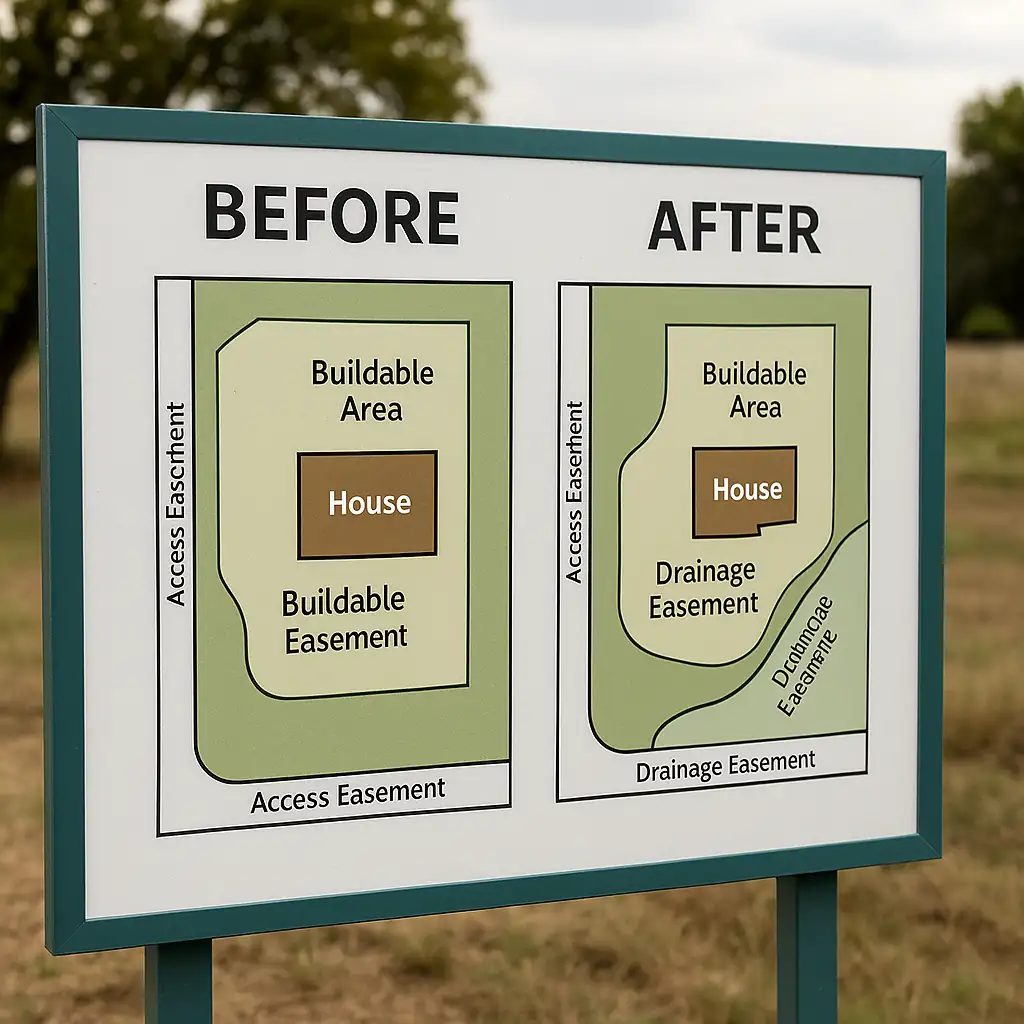
Results
- Optimized layout: house + outbuildings with no major constraints;
- Controlled costs: under budget thanks to reconfiguration ;
- On schedule: no easement-related delays;
- Preserved value: resale 18 months later, +15% capital gain.
Lessons learned
The initial investment in a detailed survey($3,500) saved $15,000 in relocations and 6 months of delays.
Common mistakes to avoid
- Superficial reading of Schedule B → critical exception forgotten.
- Assuming a "grassy" strip is free → often wrong.
- Neglect drainage → first heavy rain = nasty surprises.
- Postpone the survey → you lose the contractual support to negotiate.
- Imagine an "easy" relocation → complex project (technical & administrative).
- Insufficient access (15 ft instead of 25 ft for machinery).
- Incomplete file → referenced documents not retrieved.
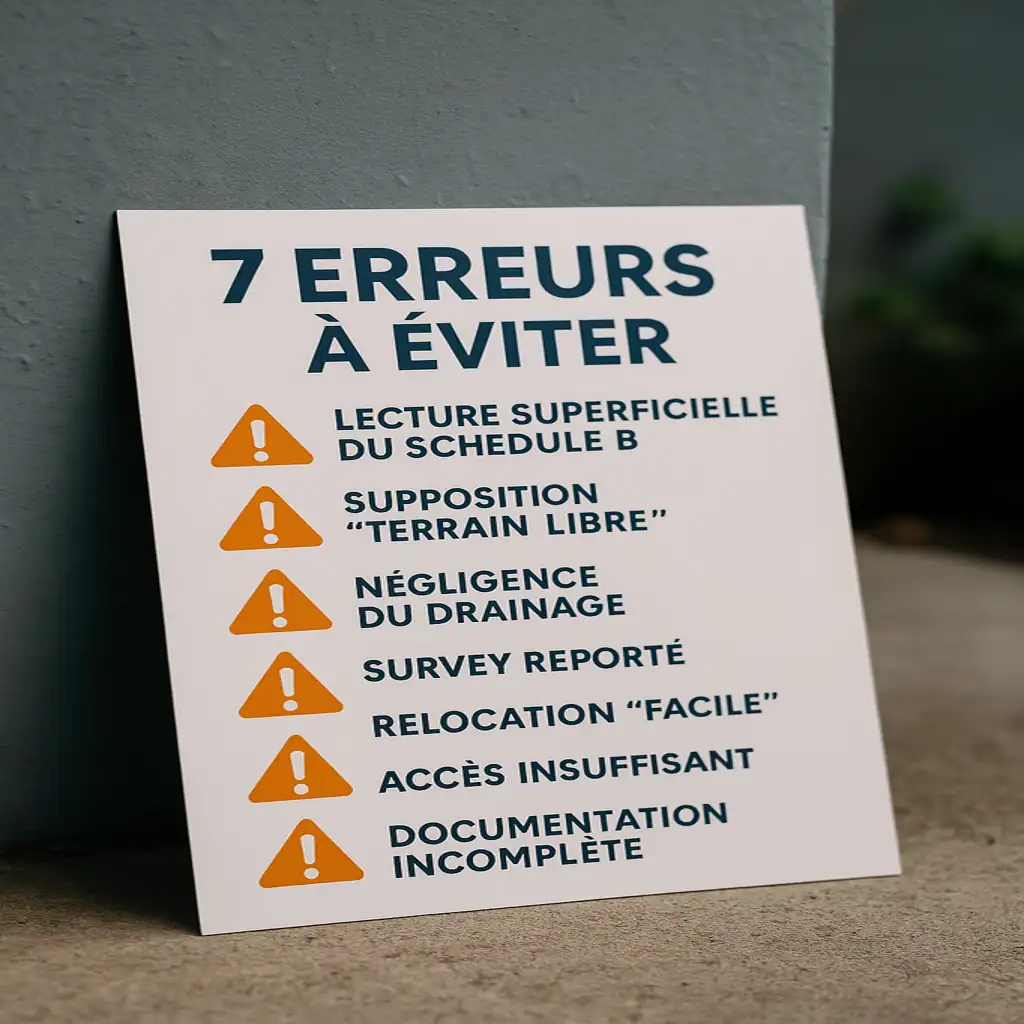
How to avoid these pitfalls
- Methodical planning: follow the 10-point checklist.
- Dedicated budget: allocate 2-3% of the purchase price to due diligence.
- Sufficient lead times: ≥ 30 days for complex sites.
- Local expertise: pros who know the county inside out.
Shopping checklist (to keep)
Before signing
- Title commitment obtained and analyzed
- Recent survey ordered (easements traced)
- Easement documents retrieved and read
- Technical compatibility (access, septic, drainage)
- Negotiated exit clauses
During due diligence
- Site visit & identified physical clues
- TxDOT/county consultation for future projects
- Relocation costing if necessary
- Validation of layout (architect/builder)
- Adjusted final budget
Customer testimonial
"Without LandQuire's Texas easement analysis, I would have placed my driveway in a drainage strip. We revised the plan and saved months."
- Cécile D., French-speaking investor
FAQ : Servitudes Texas terrain
How to check Texas servitudes before signing?
Ask for the title commitment, have an up-to-date survey drawn up and have the documents proofread by a specialized attorney. Negotiate a termination clause during the option period.
Can I build on a utility or drainage easement?
Generally not, or only under very strict conditions. Any obstruction to access/maintenance may be penalized. Validate any exceptions in writing before building.
🔗 Ref. : TxDOT - Construction & Utilities
Is an access easement enough to obtain a permit?
It all depends on width, gauge and local standards. Check county requirements and compatibility with your structures (culverts, slope).
How do you negotiate when an easement devalues the lot?
Use due diligence to reconfigure the layout, obtain a discount, or study relocation with the owners. Document costs and deadlines to support your arguments.
Can easements change after purchase?
Yes: modification/extension/creation possible, especially for public utility purposes. Hence the importance of monitoring TxDOT/comtal projects.
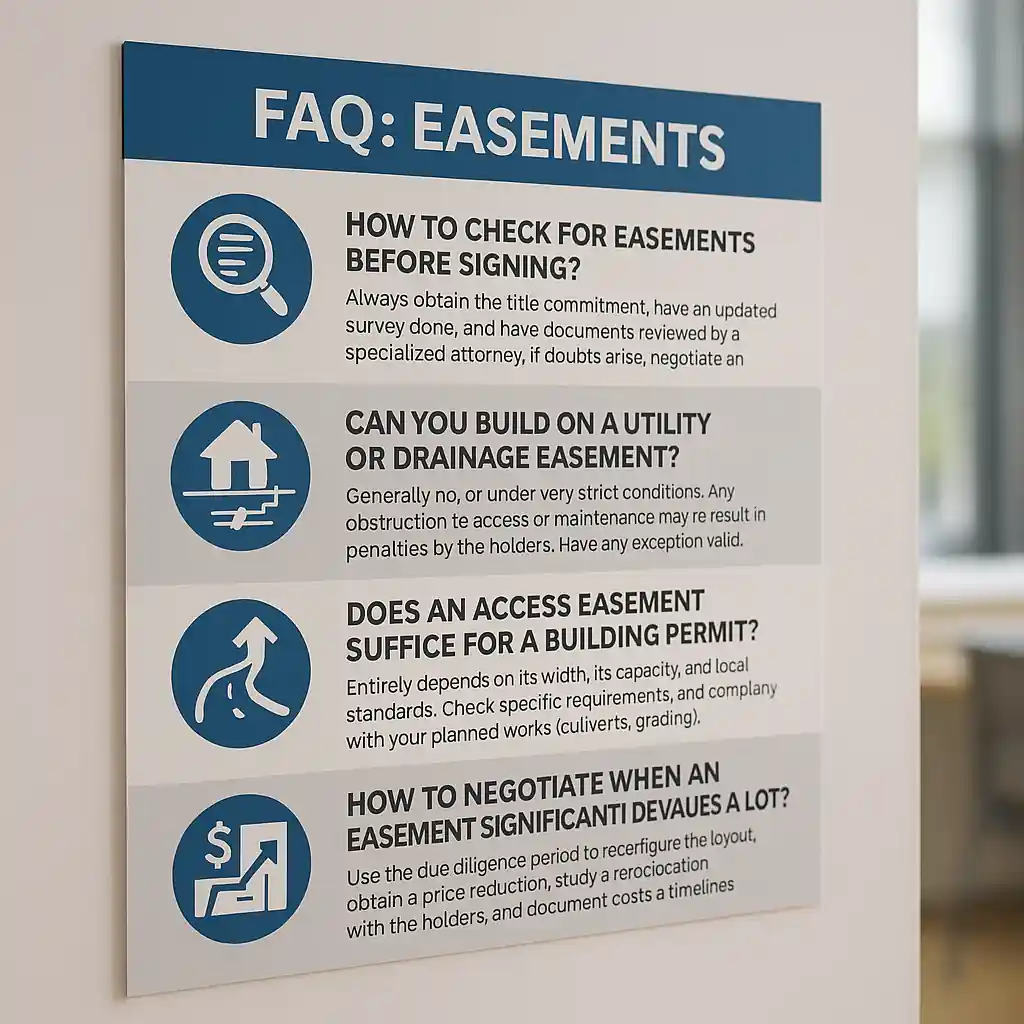
Conclusion & Contact
Texas servitudes are not traps: they are rules of use to be mapped, integrated into your plans and negotiated intelligently. The key lies in three pillars: rigorous anticipation, technical expertise (title review + survey) and informed negotiation (deadlines, clauses, reconfiguration). With this method, you secure the use, timing and value of your investment.
Tell us about your project in Texas:
✅ "Easements & constructability" audit - ✅ Optimized site plan - ✅ Ready-to-use checklist
👉 Texas field contact
👉 Our news LinkedIn
External sources (clickable)
- Texas State Law Library - Easements (Neighbor Law Guide): definitions, easement creation/termination, useful resources.
🔗 https://guides.sll.texas.gov/ - Texas A&M AgriLife - Easements 101: servient/dominant estate, forms of easements, practical examples.
🔗 https://agrilifeextension.tamu.edu/ - Texas Real Estate Research Center (Judon Fambrough) - Easements in Texas: detailed overview of private/public easements.
🔗 https://recenter.tamu.edu/ - TxDOT - Right of Way & Utilities: ROW acquisition process and utilities/relocations coordination.
🔗 https://txdot.gov/